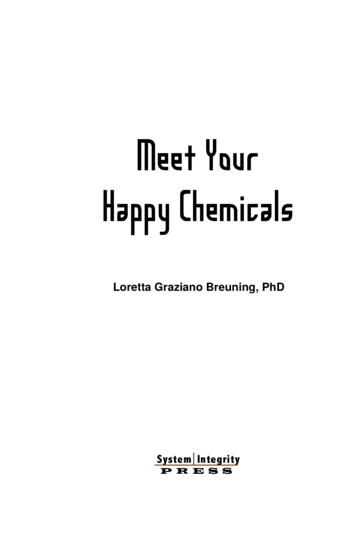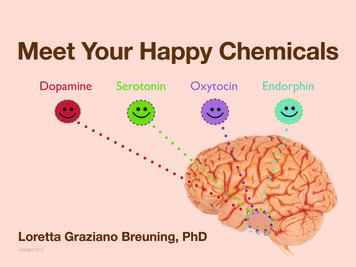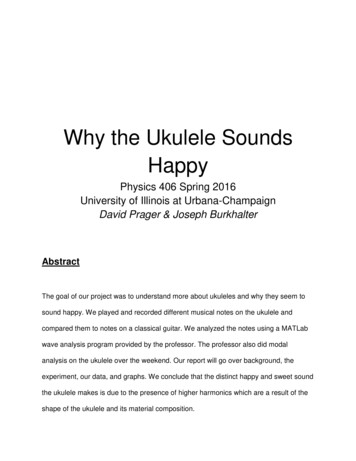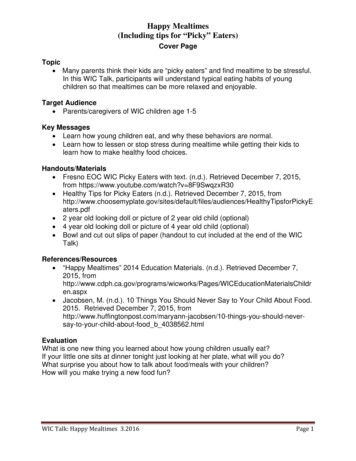
Transcription
Meet YourHappy ChemicalsLoretta Graziano Breuning, PhDSystem IntegrityP R E S S
more books by Loretta G. Breuning, PhDBeyond CynicalTranscend Your Mammalian NegativityI, MammalWhy Your Brain Links Status and HappinessGreaselessHow to Thrive without Bribes in Developing Countriesfree resources for this book atwww.MeetYourHappyChemicals.comcopyright 2012Loretta Graziano Breuningall rights reservedthird edition978-1463790929information and reproduction rights:LBreuning@SystemIntegrityPress.com
Table of ContentsIntroduction11 Meet Your Happy Chemicals242 Good Reasons to Be Unhappy473 From Vicious Circle to Virtuous724 How Your Brain Wires Itself985 Building New Happy Circuits1206 Choosing Unhappiness1497 The Burden of Choice166Author’s Note177Source Notes189Postcards from the Brain195Index202
for mywonderfulhusband, Bill
IntroductionHappy Chemicals Turn Off So They Can Turn OnThe feeling we call “happiness” comes from four specialbrain chemicals: dopamine, endorphin, oxytocin and serotonin.These “happy chemicals” spurt when your brain sees somethinggood for your survival. Then they turn off, so they’re ready tospurt again when something good crosses your path.Each happy chemical triggers a different good feeling.Dopamine produces the joy of finding what you seek– the“Eureka! I got it!” feeling. Endorphin produces the oblivion thatmasks pain– often called “euphoria.” Oxytocin produces thefeeling of being safe with others– now called “bonding.” Andserotonin produces the feeling of being respected byothers–“pride.”“I don’t see happiness this way,” you may say. You don’tthink this in words because neurochemicals work withoutwords. But you can easily see these motivations in your fellowman. And research shows that animals have these same basicneurochemicals doing the same basic jobs. As for yourself, it’seasy to believe that your verbal inner voice is your wholethought process, and ignore your neurochemical self.Happy chemicals are controlled by tiny brain structuresthat all mammals have in common: the hippocampus, amygdala,1
Meet Your Happy Chemicalspituitary, hypothalamus, and other parts collectively known asthe limbic system. In humans, the limbic system is surroundedby a huge cortex. These two different brain systems are alwaysworking together, trying to keep you alive and keep your DNAalive. Each has its special job. Your cortex looks for patterns inthe present that match patterns you stored in the past. Yourlimbic system releases neurochemicals that tell your body “this isgood for you, go toward it,” and “this is bad for you, avoid it.” Yourbody doesn’t always act on these messages because your cortexcan override them. Then, your limbic system tries again. Thecortex can over-ride the limbic system momentarily, but yourmammal brain is the core of who you are.Four happy chemicalsdopaminethe joy of finding what you seekendorphinthe oblivion that masks painoxytocinthe safety of social bondsserotoninthe security of social dominance 2012 L. BreuningYour brain rewards you with good feelings when you dosomething good for your survival. Each of the happy chemicalsmotivates a different type of survival behavior. Dopaminemotivates you to get what you need, even when it takes lots of2
Loretta Graziano Breuningeffort. Endorphin motivates you to ignore pain so you canescape from harm when you’re injured. Oxytocin motivates youto trust others, to find safety in companionship. And serotoninmotivates you to get respect, which expands your matingopportunities and protects your offspring.Happy survival motivesdopaminekeep seeking rewardsendorphinignore physical painoxytocinbuild social alliancesserotoninget respect from others 2012 L. BreuningThe mammal brain motivates a body to go towardthings that trigger happy chemicals, and avoid things that triggerunhappy chemicals. You can restrain yourself from acting on aneurochemical impulse, but then your brain generates anotherimpulse. You are always using neurochemicals to decide what isgood for you and what to avoid. Your cortex helps by directingattention and sifting information, but your limbic brain sparksthe action.We struggle to make sense of our neurochemical upsand downs because they don’t come from verbal logic. Theycome from the operating system we’ve inherited from our3
Meet Your Happy Chemicalsancestors. Once you know how the mammal brain works, yourneurochemical ups and downs are easier to accept.Happy chemicals did not evolve to be on all the time.They evolved to promote your survival. It may not seem thatway because the mammal brain defines survival its own way. Itrelies on early experience, even though children can’tunderstand survival realistically. And it cares as much for thesurvival of your genes as it does for your body.This quirky brain complicates the business of beinghuman. We have no choice but to work with the brain we’ve got.If you know how it works, you can get more happy chemicalsfrom it, and avoid more unhappy chemicals.It’s foolish to think of your cortex as the good guy andyour limbic system as the bad guy. You need both to make senseof the world around you. Your cortex sees the world as a chaos ofdetail until your limbic system labels things as good for you orbad for you. More important, your cortex cannot produce happychemicals. If you want to be happy, you have to get it from yourlimbic system.But your cortex and your limbic system are literally noton speaking terms. That’s because the limbic system can’tprocess language. When you talk to yourself, it’s all in yourcortex. The limbic system never tells you in words why it isspurting a happy or unhappy chemical. Animals accept theirneurochemical impulses without expecting a verbal rationale.That’s why animals can help us make sense of our own brainchemicals. The goal here is not to glorify animals or primitiveimpulses. The goal is to understand our neurochemical ups anddowns.4
Comparing brain partsLoretta Graziano Breuningcortexextra neurons that store lifeexperience by growing andinterconnectinglimbicsystemstructures that manage neurochemicals, such as the amygdala,hippocampus, hypothalamusreptilianbrainthe cerebellum and brain stem(medulla oblongata and pons), whichmanage routine bodily functionshumanchimpanzeegazellemouselizard 2012 L. Breuning5
Meet Your Happy ChemicalsA hungry lion is happy when he sees prey.1 It’s notphilosophical happiness. His happy chemicals cause a state ofarousal that releases energy for the hunt. Lions often fail in theirhunts, and they choose their targets carefully to avoid runningout of energy before they get to eat. So a lion is thrilled when hesees a gazelle close at hand. His dopamine surges, which revs uphis motor to pounce.A thirsty elephant is happy when he finds water. Thegood feeling of quenching his thirst triggers dopamine, whichmakes permanent connections in his neurons. That helps himfind water again in the future. He need not “try” to learn wherewater is. Dopamine simply paves a neural pathway. The nexttime he sees any sign of a water hole, electricity zips down thepath to his happy chemicals. The good feeling tells him “here iswhat you need.” Without effort or intent, happy chemicalspromote survival.But happy chemicals don’t flow constantly. The liononly gets more happy chemicals when he finds more prey, andthe elephant only spurts when he meets a survival need. Innature, there is no free happy chemical. Good feelings evolvedbecause they get us to keep doing things that promote survival.Your Happy TrailsYour feelings are unique. You have unique ways to turnon your happy chemicals because you built neural pathwaysfrom your unique life experience. When something made youfeel good as a child, the happy chemicals built connections.1 I use the male pronoun in this book because it combines with my female voice to convey the universalaspects of brain function. Female lions do most of the hunting, in fact, but gender differences are widelyexpounded elsewhere. This book focuses on the physiology that both genders have in common.6
Loretta Graziano BreuningWhen something felt bad, your unhappy chemicals seared thatinformation, too. Over time, some of your neural pathwaysdeveloped into superhighways because you activated them a lot.The survival system you ended up with is not what you’d designtoday if you started from scratch. It’s the survival system thatemerged from real experience.Your existing neural highway system makes it easy foryou to like some things and dislike other things. Often, we findourselves liking things that are not especially good for us, andfearing things that are good for us. Why would a brain thatevolved for survival build such quirky pathways?Because the brain builds on the pathways it already has.We evolved to store experience, not to delete it. Most of thetime, experience holds important lessons. It helps us go towardthings that helped us in the past and avoid things thatendangered us. But a huge surge of happy chemical builds a hugepathway, even if too much of a good thing can hurt you. A bigsurge of unhappy chemical builds a big circuit that lasts evenwhen the threat is gone. This promotes survival in a worldwhere good things are scarce, and threats are enduring. Yourbrain relies on its pathways as if your life depended on it becausein the state of nature, it does.You built circuits effortlessly when you were young.Building new circuits in adulthood is like trying to slash a newtrail through dense rainforest. Every step requires a huge effort,and the new trail disappears into the undergrowth if you don’tuse it again soon. Such trail-blazing feels inefficient anddownright unsafe when a nice superhighway is nearby. That’swhy people tend to stick with the pathways they have.7
Meet Your Happy ChemicalsYou can build new trails through your jungle of neurons,which can turn on your happy chemicals in new ways. It’s harderthan you’d expect, but it’s easier when you know yourequipment.The electricity in your brain flows like water. It finds thepath of least resistance. Electricity doesn’t flow easily alongneurons you’ve never activated before. Each time a neuralpathway is activated, electricity flows more easily. Repetitiondevelops a neural trail slowly, the way a dirt path hardens fromyears of use. But neurochemicals develop a neural trail instantly,the way asphalt paves a dirt road. Your neural network grewfrom things you experienced repeatedly and things youexperience neurochemically.Once you’ve built highways to your happy chemicals,you use them, because it feels like you’re promoting survival.New highways are hard to build in later life. You can always addnew leaves to your neural branches, but it’s harder to add newroots. It’s possible, but it doesn’t happen in the effortless way itdid in youth. You have to spend a lot of time choosing theexperiences you feed to your brain. No one can build newpathways for you, and you cannot build them for someone else.But this book will help by showing just what stimulates happychemicals and what connects neurons. It can be your guide asyou work to slash new roads and avoid old ones.This brain we’ve inherited is frustrating. In its quest forsurvival, it often turns unhappy chemicals on and happychemicals off. When my neurochemistry frustrates me, I remindmyself that it has succeeded at promoting survival for millions ofyears.8
Loretta Graziano BreuningThe Vicious Cycle of Happy ChemicalsWhen your unhappy chemicals flow, you don’t usuallyrespond by thanking them for promoting your survival. Instead,you focus on ways to trigger happy chemicals. For example,when hunger triggers a bad feeling, a mammal seeks food. Whencold triggers a bad feeling, a mammal seeks warmth. Just findingfood and warmth triggers happy chemicals, before you actuallyeat or warm up. Happy chemicals flow when you see a way tomeet your needs.The human cortex is good at avoiding bad feelings. Weavoid hunger and chill by planting food and stocking fuel. Butunhappy chemicals remain, no matter how well we meet ourneeds. As soon as you’re warm and fed, your brain scan for otherthings that can hurt you. Your survival is threatened as long asyou’re alive, and your brain never stops looking for survivalthreats.A mammal must take risks to get its needs met. It risksgetting killed by a predator while foraging for food. It risks socialconflict when seeking mates. It risks losing its offspring beforegrandchildren have been produced to preserve its genes.Unhappy chemicals are the brain’s way of alerting us to suchrisks.Unhappy chemicals feel bad because that works. It getsyour attention, fast. It’s comforting to know that bad feelingshave a purpose. When a hungry gazelle smells a lion, badfeelings motivate it to run rather than keep eating. The gazellesurvives because the smell of a lion triggers a feeling that’s muchworse than ordinary hunger. Once the gazelle escapes from thelion, the bad feeling of hunger gets its attention again, and itlooks for a safe place to forage. We are alive today because9
Meet Your Happy Chemicalsunhappy chemicals got our ancestors’ attention to one survivalthreat after another.Bad feelings are produced by cortisol. Your response tocortisol depends on what it’s paired with, be it low blood sugar,the scent of a predator, social exclusion, or myriad other dangersignals. When your cortisol flows, it links the neurons active inyour brain at that moment. This wires you to recognize thosedanger cues in the future. A young gazelle has cortisol spurtswhile following its mother, and the pathways it builds prepare itto survive when its mother is gone. Survival knowledge buildswithout effort or intent because neurochemicals pave pathways.When you feel a cortisol alert, your brain looks for a wayto make it stop. Sometimes the solution is obvious, like pullingyour hand off a hot stove. But bad feelings don’t always haveobvious causes. And they don’t always have obvious cures. Suchfeelings keep commanding your attention with the sense thatyou must “do something.” Your brain keeps scanning the worldfor a way to make bad feelings stop.That “do something” feeling promotes survival, but italso causes trouble. It motivates us to do anything that stops thecortisol. Can eating a donut fix a career or romantic setback?From your brain’s perspective, it can. Consciously, you know thedonut doesn’t solve the problem. But when something changesunhappy chemicals to happy chemicals, your brain learns fromthe experience. When donuts trigger happy chemicals (becausefat and sugar are scarce in nature), a neural pathway is paved.The next time you have that “do something” feeling, thispathway is one “something” you “know.” You may not act on it,because you also know the consequences, and you’ve built other10
Loretta Graziano Breuning“do something” pathways. But it remains in your mammal brain’sarsenal of survival strategies.Cortisol is triggered by disappointment. Your mammalbrain alerts you when your expectations are not met. That “dosomething!” feeling gets your attention as long as expectationsof romance or success are disappointed, and your brain respondswith the strategies it has learned.We evolved to learn from experience. It might seem thatpeople don’t learn from experience until you look at itneurochemically. Neurochemicals are molecules that makephysical changes in the brain. These changes help you navigatethrough the world by triggering good or bad feelings whensomething felt good or bad in your past. This promotes survivalwhen things that trigger good feelings are good for survival. Andwhen these feelings are bad for survival, we can “second guess”our neurochemical steering mechanism with our big cortex.That’s what the cortex evolved for. But it can’t work alone. It isalways working along with our neurochemistry.Each brain has a network of connections built fromexperiences that felt good in the past. These connectionsrepresent simple things like donuts and complex things likesocial trust and practical skills. By the time you are old enoughto choose your own course of action, you already have a brainfull of circuits that turn your neurochemicals on and off. Thesecircuits are what you “know” about how to survive in the world.You can stop yourself from acting on your neurochemicalimpulses, which gives your brain time to search for a Plan B. Butyou are always relying on your existing pathways to plot a coursethat leads away from cortisol and toward happy chemicals.11
Meet Your Happy ChemicalsWhen you succeed at triggering happy chemicals, thespurt is soon over. To get more, you have to do more. That ishow a brain keeps prodding a body to do what it takes to keep itsDNA alive. Happy chemicals get re-absorbed and yourawareness of survival threats resumes. You get that “dosomething” feeling, and you ponder your options by sendingelectricity down the pathways you have.The brain’s quest for happy chemicals often leads to avicious cycle because of the side effects. “Everything I like isillegal, immoral or fattening,” goes the old saying. Happychemicals exist because of their side effects, thanks to naturalselection. When happy chemicals dip and we seek more, we getmore side effects. They can accumulate to the point where theytrigger unhappy chemicals. Now, the behavior you use to triggerhappiness creates more unhappiness. And the more cortisol youproduce, the more motivated you are to repeat the behavior youexpect to make you happy. You are wired for frustration.Vicious cycles are everywhere. Some of the mostfamiliar ones are alcohol, junk food, compulsive spending, anddrugs. Other well-known vicious cycles are risk-taking, gettingangry, falling in love, and rescuing others. Each of thesebehaviors can make you feel good in a moment when you werefeeling bad. The good feeling means happy chemicals arebuilding connections, making it easier to trigger good feelings inthat way in the future. Over time, a neural superhighwaydevelops. Now your brain activates that behavior effortlessly.But too much of a good thing triggers unhappy chemicals, whichlet you know that it’s time to stop. It’s hard to stop, however,because your brain seeks happy chemicals. So the same behavior12
Loretta Graziano Breuningcan trigger both happy and unhappy feelings at once, like drivingwith one foot on the accelerator and one on brake.You can stop this vicious cycle in one instant. Just resistthat “do something” feeling and live with the cortisol. This is noteasy because cortisol screams for your attention. It did notevolve for you to sit around and accept it. But you can build theskill of doing nothing during a cortisol alert, despite that urge tomake it go away in any way possible. That frees you to activatean alternative happy circuit instead of the old-familiar one. Avirtuous circle starts in that moment.But what if you don’t have an alternative circuit at theready? That’s where this book comes in. It shows how newhighways to your happy chemicals can be built. That may feel13
Meet Your Happy Chemicalsawkward because we rely so heavily on circuits that builtthemselves. We’ve all built circuits with conscious effort, likethe ones that do long division and define vocabulary words. Butthe circuits that tell you what’s good and bad for you are builtfrom lived experience. You have to feed your brain newexperiences for it to learn new ways of feeling good. And youhave to keep doing it until the new circuit is big enough tocompete with the ones you’ve already built by accident.We think it should be easy to build new circuits sinceour old ones got there without struggle. This book shows whyit’s so hard to remodel your neural infrastructure.Your brain likes your old circuits, even when they leadyou astray. That’s because electricity zipping down a well-wornpathway gives you the feeling that you know what’s going on.When you refuse to use your old pathways, you may feel lost.You may even feel like you’re threatening your own survival,though you’re doing precisely the opposite.The bad feeling of resisting a habit eases once a newhabit forms. You can do that in 45 days. If you repeat a newthought or behavior every day without fail, in 45 days a newpathway will invite electricity away from the old path. The newchoice will not make you happy on Day 1, and it may not makeyou happy on Day 40. Even on Day 45, your new circuit cannottrigger happy chemicals constantly. But it can trigger enough tofree you from a vicious cycle. On Day 46, you’ll be ready to startbuilding another new circuit. Over time, you can build manynew ways to trigger happy chemicals, as long as you’re willing torepeat a behavior for 45 even if it doesn’t feel good.A vicious cycle is easy to see in someone else. That’swhy people are often tempted to take charge of other people’s14
Loretta Graziano Breuninghappiness, even while doing nothing about a vicious cycle oftheir own. But each person must manage their own limbicsystem. No one else can reach into your brain and trigger yourhappy chemicals for you. Only you can make connections inyour brain, and you cannot make connections in someone else’sbrain. If you focus your life on other people’s brains, you may failto fix their vicious cycles and your own.Modern society is not the cause of vicious cycles. Ourancestors had their own variations. They felt good when theymade human sacrifices, and when the good feeling passed theymade more sacrifices. Over time, humans developed better waysto trigger happy chemicals and avert unhappy chemicals.It’s not easy being a mammal with a big cortex. We haveenough neurons to imagine things that don’t exist instead of justfocusing on what is. This allows us to improve things, but it alsoleave us feeling that something is wrong with the world as it is. Avicious cycle often results. The more you make yourself happyby imagining a “better world,” the less invested you are in theworld as it is. This can lead to bad decisions that trigger unhappychemicals, motivating you to live in your imagined world evenmore. Reality is a disappointment compared to the ideal worldthat a cortex can imagine.What About Love?You’ve probably heard that loving others is the key tohappiness. It’s a good principle, but it only provides limitedinsight into your happy chemicals.Love triggers huge neurochemical ups and downsbecause it plays a huge role in the survival of your genes. Our15
Meet Your Happy Chemicalsbrain uses happy chemicals to reward behaviors that promotewhat biologists call “reproductive success.” You may not careabout reproducing and you surely have another definition forsuccess. You may feel sure that your love is selfless andcompletely unconcerned with your genes. But you are heretoday because your ancestors successfully competed for matesand kept their offspring alive long enough to successfully mate.Your limbic system was naturally selected over millions of yearsfor its ability to reproduce. As soon as a mammal is safe fromimmediate harm, its thoughts turn to reproductive success in allof its aspects.Sex and romance are just the obvious examples.Nurturing children promotes your genes, so it’s not surprisingthat it stimulates happy chemicals. Competing successfully forquality mates promotes your genes, and it stimulates happychemicals. Over the millennia, some DNA made a lot of copiesof itself and some made none at all. A conscious intent toreproduce is not necessary for neurochemicals to motivatebehavior. For example, animals avoid in-breeding. They don’t dothat consciously, but natural selection weeded out in-breeders,leaving brains that produced alternative behaviors to flourish.Our brains are inherited from the flourishers.Unhappy chemicals promote reproductive success too.In nature, females often watch their offspring get eaten alive bypredators, and males suffer conflict and rejection in their questfor mates. The bad feeling of cortisol motivates an animal to dowhat it takes avoid threats and trigger happy chemicals. Badfeelings motivate a mother mammal to guard her childconstantly, and search for the nourishment she needs to sustain16
Loretta Graziano Breuningher milk. Bad feelings motivate a male mammal to avoidconflicts he’s likely to lose, and risk conflicts he’s likely to win.Social alliances promote reproductive success in thestate of nature. Mammals with more social allies and more statusin their social group tend to have more surviving offspring.Natural selection produced a brain good at social skills as aresult. The mammal brain promotes social success by rewardingit with happy chemicals. And if your social standing isthreatened, the mammal brain warns you with cortisol becauseit’s a threat to your DNA in the state of nature.Each happy chemical rewards love in a different way.When you know how each one is linked to reproductive success,the frustrations of life make sense.Dopamine is stimulated by the “chase” aspect of love. It’salso triggered when a baby hears his mother’s footsteps.Dopamine alerts us that our needs are about to be met. Femalechimpanzees are known to be partial to males who share theirmeat after a hunt. Females reproduction depends heavily onprotein, which is scarce in the rainforest. So opportunities tomeet this need trigger lots of dopamine. For humans, finding“the one” makes you high on dopamine because a longer questto meet a need stimulates a longer surge.Oxytocin is stimulated by touch, and by social trust. Inanimals, touch and trust go together. Apes only allow trustedcompanions to touch them because they know from experiencethat violence can erupt in an instant. In humans, oxytocin isstimulated by everything from holding hands to feelingsupported to orgasm. Holding hands stimulates a small amountof oxytocin, but when repeated over time, as in the case of anelderly couple, it builds up a circuit that easily triggers social17
Meet Your Happy Chemicalstrust. Sex triggers a lot of oxytocin at once, yielding lots of socialtrust for a very short time. Childbirth triggers a huge oxytocinspurt, both in mother and child. Nurturing other people’schildren can stimulate it too, as can nurturing adults, dependingon the circuits one has built. Friendship bonds stimulateoxytocin, and in the monkey and ape world, research shows thatindividuals with more social alliances have more reproductivesuccess.Serotonin is stimulated by the status aspect of love– thepride of associating with a person of a certain stature. You maynot think of your own love in this way, but you can easily see it inothers. Animals with higher status in their social groups havemore “reproductive success,” and natural selection created abrain that seeks status by rewarding it with serotonin. This maybe hard to believe, but research on huge range of species showstremendous energy invested in the pursuit of status. Socialdominance leads to more mating opportunity and moresurviving offspring– and it feels good. We no longer try tosurvive by having as many offspring as possible, but when youreceive the affection of a desirable individual, it triggers lots ofserotonin, though you hate to admit it. And when you are thedesired individual, receiving admiration from others, thattriggers serotonin too. It feels so good that people tend to seek itagain and again.Endorphin is stimulated by physical pain. Crying alsostimulates endorphin. If a loved one causes you pain, theendorphin that’s released paves neural pathways, wiring you toexpect a good feeling from pain in the future. People maytolerate painful relationships because their brain learned toassociate it with the good feeling of endorphin. Confusing love18
Loretta Graziano Breuningand pain is obviously a bad survival strategy. Roller-coasterrelationships are easier to transcend when you understandendorphin.The sex hormones, like testosterone and estrogen, arecentral to the feelings we associate with love. They are outsidethe scope of this book, however, because they do not trigger thefeeling of happiness. They mediate specific physical responsesinstead.Why did the brain evolve so many different ways tomotivate reproductive behavior? Because keeping your DNAalive is harder than you’d think. Survival rates are low in the stateof nature, and mating opportunities are harder to come by thanyou might expect. Your genes got wiped off the face of the earthunless you made a serious effort. Of course, animals don’tconsciously intend to promote their genes. But every creaturealive today has inherited the brain of ancestors who did what ittook to reproduce.There is no free love in nature. Every species has apreliminary qualifying event before mating behavior. Creatureswork hard for any mating opportunity that comes their way. Inthe end, some DNA makes lots of copies of itself, while otherDNA disappears without a trace. You may say you don’t careabout your DNA, but you’ve inherited a limbic system that does.Unhappy chemicals creep into your life as you seek lovein all its forms. Animal brains release cortisol when their socialovertures are disappointed. The bad feeling motivates the brainto “do something.” It reminds you that your genes will beannihilated if you don’t get busy. You don’t need to tell yourselfthat in words. Natural selection created neurochemicals that giveyou the message non-verbally.19
Meet Your Happy ChemicalsLosing love triggers a huge surge of unhappy chemical.That actually promotes genetic survival because the pain youassociate with the old attachment leaves you available for a newattachment. The brain has trouble ending attachments becausethe oxytocin pathway is still there. But if you can’t break anattachment, your genes are doomed. The pain of lost love rewires your brain so you can move on. Cortisol promotes love byhelping you avoid places where you’re not getting it.Love often disappoints for a subtle reason that’s widelyoverlooked. A young child learns to expect others to meet theirneeds. Children cannot
But happy chemicals don’t flow constantly. The lion only gets more happy chemicals when he finds more prey, and the elephant only spurts when he meets a survival need. In nature, there is no free happy chemical. Good feelings evolved because they get us to keep doing things










